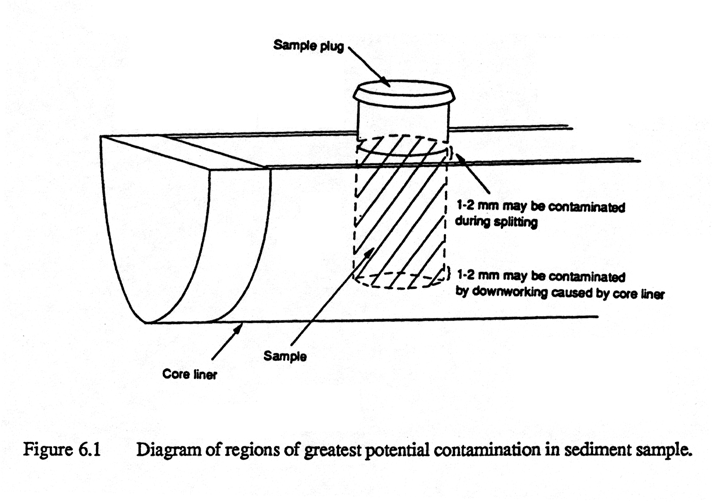
The purpose of this chapter is to discuss some problems encountered by paleomagnetists on the Resolution so that they can be avoided in the future. Information from previous legs has been gleaned from the Explanatory Notes" and Site Chapters" of the Initial Reports, papers by paleomagnetists in the Scientific Results, and the Paleomagnetic Specialist Reports.
When measuring sections of core in the MST or the cryogenic magnetometer, paleomagnetists must find a balance between having measurement intervals as closely spaced as they would like, and the potential that making large numbers of such measurements has to slow down the flow of cores in the core lab, thereby preventing shipboard sedimentologists and other scientists from performing their duties. In shallow water, drilling in relatively easily cored (APC) sediments, cores can arrive on deck only 15 to 30 minutes apart. As Table 6.1 illustrates, measuring a 7-section core on the MST takes about 40 minutes. Performing several AF-demagnetization steps can take much longer. This problem should be discussed with the Co-Chief Scientists and the shipboard party so that a strategy can be determined to permit cores to be described and measured optimally.
Paleomagnetists should be aware of some possible sources of contamination and how to minimize the effects. Figure 6.1 illustrates a sampling plug inserted into a core, with regions of highest potential contamination indicated. The split surface of the working and archive core halves may be contaminated by the wire or saw during the splitting process, or by handling on the sampling table. The outer surface of the core (in contact with the core liner) may be contaminated by younger material displaced downhole by the core liner during the coring process.
Distance between Magnetic Time/ Section Time/Core Measurements Susceptibility (7 Sections) (cm) Range 10 1.0 5 min 50 sec 40 min 50 sec 5 1.0 6 min 50 sec 47 min 50 sec 3 1.0 7 min 15 sec 50 min 45 sec 10 0.1 8 min 30 sec 59 min 30 sec 5 0.1 11 min 15 sec 1 hr 19 min 3 0.1 15 min 1 hr 45 min Table 6.1 MST timing measurements, Leg 134.

These regions (each roughly a few millimeters thick) should be trimmed away before processing the sample. Other regions of the core with high contamination potential are the top 10-20 cm (or more) of each core, zones of flow-in at the base of some advanced hydraulic piston (APC) cores, the drilling paste between "biscuits" in some extended core barrel (XCB) or rotary core barrel (RCB) cores, and any other interval displaying high drilling disturbance. Information about core disturbance is recorded on the visual core descriptions and barrel sheets by the sedimentologists; it is recommended that as part of their shore-based studies paleomagnetists compare their personal sample inventory with the barrel sheets for evidence of disturbance (and thus contamination).
The Handbook for Shipboard Sedimentologists lists three common types of drilling disturbance in sediments and sedimentary rocks recovered by ODP (Mazzullo and Graham, 1988):
1. Bed flexures: The weight of the drill string can flex or bow downward beds of soft sediment. Soft material can also be bowed or flexed upward while the core barrel is pulled out of the hole. Beds that are flexed only along their edges are considered slightly deformed, beds that are bowed across the core are termed moderately deformed, and beds that display diapir-like structures are completely disturbed.
2. Soupy beds: Sediment that is water-saturated can flow up into a core barrel under the weight of the drillstring; the original bedding and the orientation of magnetic particles in these sediments are destroyed (Figs. 6.2 - 6.4). This can occur in sand, calcareous grainstones, and ooze, and is common in the mud-line core in poorly consolidated sediments.
3. Fractures: Beds of hard sedimentary rock can be fractured by excess drill pressures. The rock can be considered slightly fractured when it is broken into a few large pieces by a small number of well-defined fractures, moderately fractured when core pieces are in place or partly displaced but original orientation is maintained, or highly fractured when pieces are probably in correct stratigraphic sequence (although they may not represent the entire sequence) but original orientation is lost. Drilling breccia is rock crushed and broken into many small and angular pieces, with original orientation and stratigraphic position lost; often, drilling breccia is completely mixed with drilling slurry (Fig. 6.5). Beds of semi-lithified sediment can also be split along their bedding planes by the rotation of the core barrel during rotary coring. In this case, the fracturing produces disc-shaped drilling biscuits that commonly float within a matrix of soupy sediment (Fig. 6.6). Drilling biscuits can be very common in rotary-cored sections, and can be difficult if not impossible to identify.
Drilling disturbance should be brought to the attention of the Operations Superintendent, because it can sometimes be lessened or prevented by changing drilling or coring techniques. Disturbance can also be caused by the tools used for splitting cores, and the Marine Specialists may be able to minimize core disturbance from this source.
The susceptibility meter on the multisensor track and the cryogenic magnetometer are both designed and intended to measure completely filled APC cores. Tests conducted during Leg 131 indicate that in places where the core is not uniformly magnetized, either through natural processes or artifacts (such as voids in the core [Figs. 6.3 and 6.4] or differential rotation of segments in the core liner), the values of declination, inclination, and intensity should be treated with caution. Sections containing substantial voids should not be measured. Database upgrades currently being designed will permit data records to include comments about the core sections, such as the presence and location of voids, so that the data can be interpreted correctly. Until then, measurement of inappropriate intervals, such as incompletely filled sections, will only serve to degrade the existing database. Future users of the database may not be able to distinguish this information from appropriately measured intervals.
Perhaps the most common complaint of paleomagnetists working with ODP
cores is the presence of a remanence thought to have been acquired during
drilling and/or recovery of the core (Figs. 6.7 and 6.8). This overprint,
which can usually be distinguished by its near-vertical inclination (i.e.,
parallel to the long axis of the core), has been reported from many DSDP and
ODP legs (e.g., Barton and Bloemendal, 1986; Bleil, 1989; Tauxe et al., 1989;
Hall and Sager, 1990; Hounslow et al., 1990; Kroenke, Berger, Janecek, et
al., 1991). The overprint is not always observed from one site to another
(Shibuya et al., 1991), and its acquisition seems to be highly dependent on
lithology, presumably reflecting the mineralogy and physical properties of
the magnetic fraction.
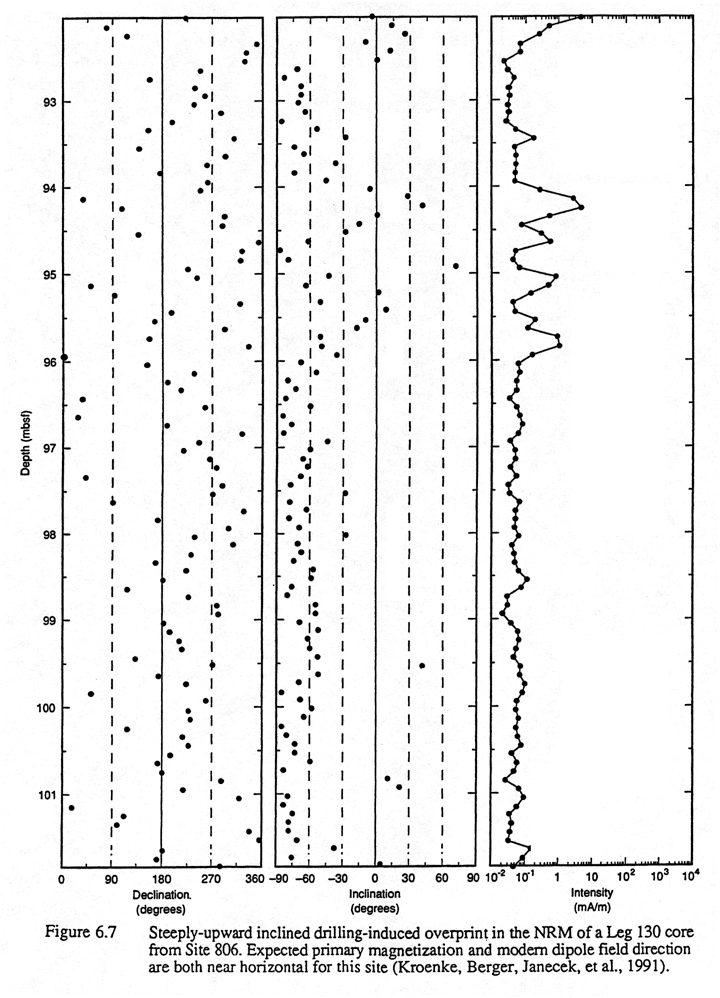
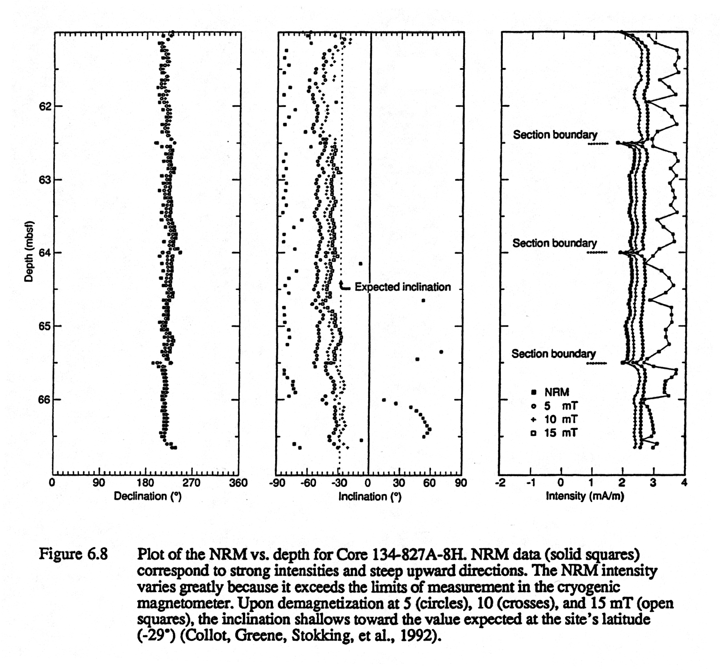
The mechanism for this overprint is not completely known. Some workers have informally referred to it as a drilling-induced VRM", but this is an inaccurate description, as the drilling-induced component is usually too strong and too stable relative to the natural" VRM to have arisen viscously. The drill string, bottom-hole assembly, and core barrel are all known to be strongly magnetized at times, and it is more likely that this component is acquired as an IRM, possibly supplemented by some form of grain alignment due to drilling-related vibration and fluidization of the cores. IRM acquisition of the drilling-induced component is also consistent with the sometimes high coercivity of the overprint; the drilling-induced remanence at times persists as a substantial part of the total remanence after demagnetization of the core at the 15-mT limit formerly placed on archive-half cleaning. The IRM origin of the drilling-induced remanence can be clearly seen in carbonate oozes and chalks from Leg 130 (Kroenke, Berger, Janecek, et al., 1991; Musgrave et al., in press), where steeply inclined components often persisted to AF levels of at least 25-35 mT (Fig. 6.9), and where spiraling anomalous magnetizations appeared to track" the passage of the core past localized hot spots" of intense magnetization on the core barrel or drill string or on the drill floor (Fig. 6.10). Magnetization in these sediments was very weak, and appeared to reside largely in magnetic iron sulfides, which may account for the exaggerated sensitivity of these sediments to this overprint.
Shipboard paleomagnetists investigating spurious magnetizations observed in cores recovered on Leg 134 (Collot, Greene, Stokking, et al., 1992) showed that the overprint was not as strong in discrete samples taken from the center of the working-half sections, suggesting that the intensity of the overprint decreased radially from the edge to the center of the core. To test this hypothesis, three discrete samples were taken and demagnetized: one from center of the core, one from the edge, and one from in between (Fig. 6.11). AF demagnetization to 5 mT isolated the primary magnetization in the sample taken from the center. The primary component of remanence in the sample taken from the outer edge of the core could be isolated only after AF demagnetization at 15 mT.
The relative importance of each of the elements of the coring system --
drill string, bottom-hole assembly (BHA), core barrel, etc. -- as a source
for the drilling-induced remanence has been debated. In some cases an
alternating pattern of large and small drilling-induced components is seen in
successive cores (e.g., Fig. 6.12), which corresponds to the alternate use of
two core barrels, one of which was presumably more strongly magnetized than
the other; it is clear in these cases that the drilling-induced component was
induced by the core barrel. In other cases overprinting has been attributed
to the drill string or the BHA. On Leg 144 intense overprinting of APC cores
was attributed to a magnaflux test of the BHA conducted before drilling.
However, magnaflux examination of the BHA uses an alternating field, as the
aim of the process is the detection of near-surface cracks at a shallow skin
depth; it is unlikely that this would result in a large permanent
magnetization, and it may in fact serve to degauss magnetizations already
present in the BHA. Other examinations of pipe connections, and of the pipe
itself, may involve the use of half-wave rectified fields which would induce
a remanence in the pipe; these tests are conducted less frequently, however.
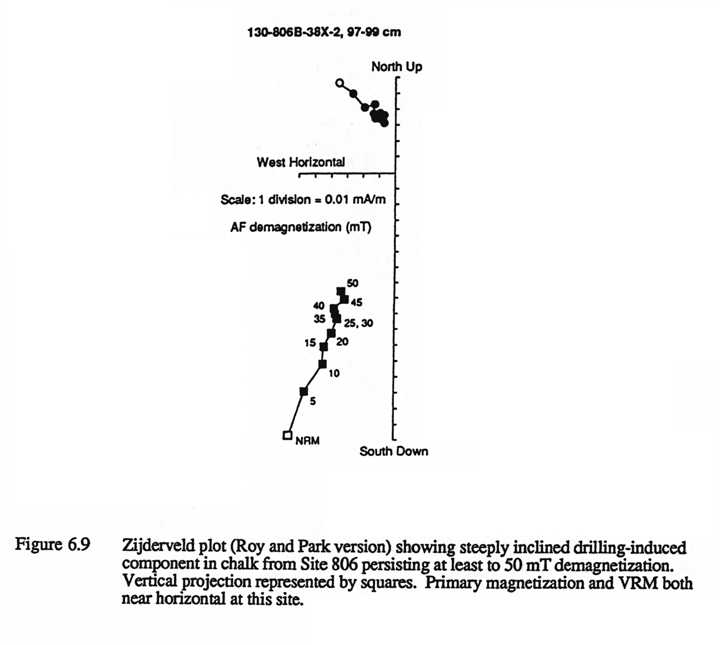
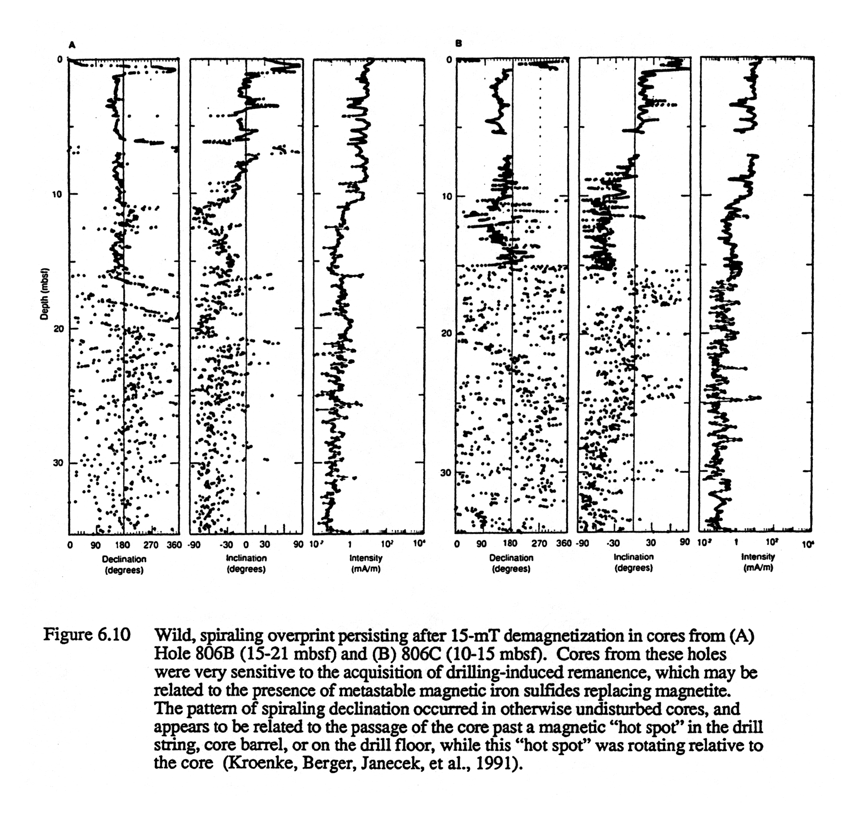
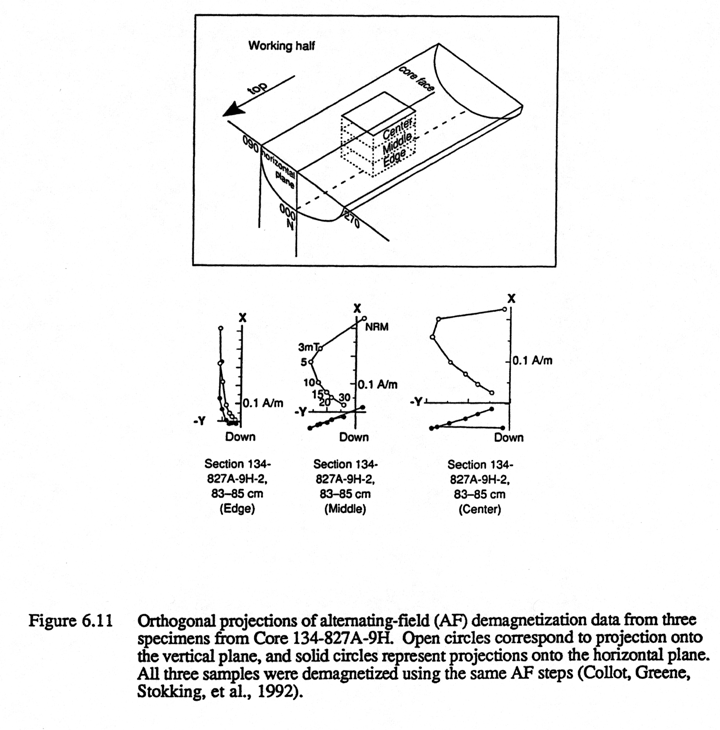
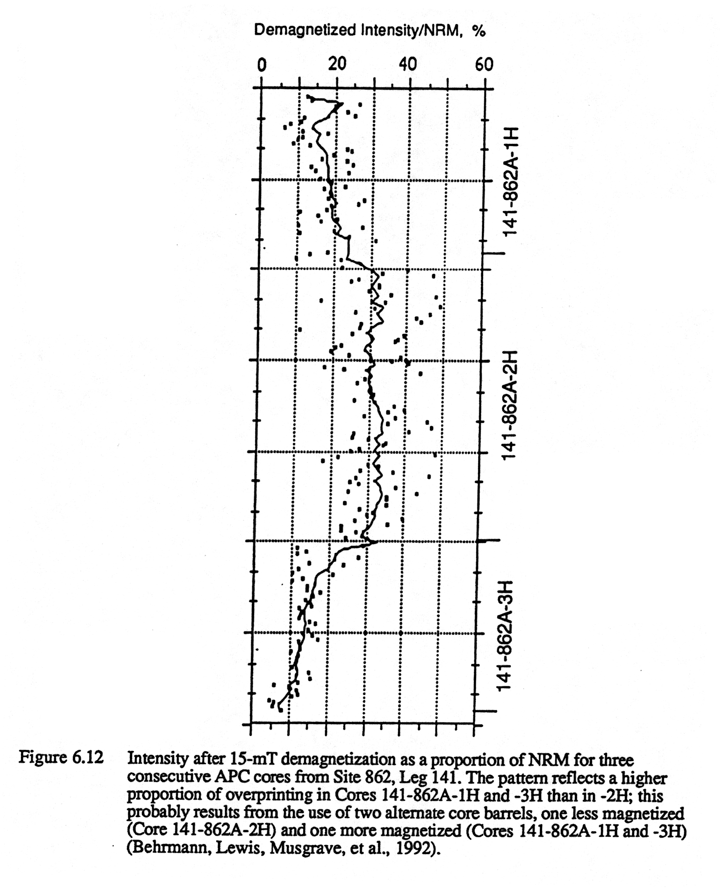
The principal cause of magnetization of the drill string, BHA, and core barrel is probably the routine jars, vibrations, and rotation stresses experienced during racking, tripping, deployment, drilling, and recovery. It is unlikely that any significant change could be made to reduce acquisition of remanence during these processes. Although nonmagnetic drill collars are deployed in the BHA when magnetic orientation of cores is carried out, it would be impractical to replace all of the BHA and/or drill string with nonmagnetic materials, both because of the far higher cost of these materials and because of their reduced tensile strength. Degaussing of the drill string by the use of an AF coil mounted beneath the drill floor has been attempted by DSDP. This resulted in the rapid physical destruction of the coil, however, and it is questionable whether the degaussing the pipe received as it was tripped had any lasting effect once the pipe was re-exposed to the shocks and vibrations related to coring. Degaussing of the core barrel has also been attempted, and previous reports (sometimes anecdotal) have provided equivocal evidence of whether this was helpful in reducing the overprint.
A quantitative test of the magnitude of the magnetization of the core barrel and the effect on this of AF demagnetization was carried out on Leg 146. The internal axial field in two core barrels was measured with a Hall Effect probe, centered along the axis of the barrel and linked to the meter by a shielded cable. The field was measured at 0.5-m intervals along each barrel. Each barrel was then demagnetized using the Smith Drilco Magnafluxer set to full-wave, and the barrel lowered down the pipe to take an APC core. After recovery of the core, the magnetization was measured again at the same intervals.
Position above Initial field (mT) Field after degaussing Field after core bottom of barrel (m) (mT) recovery (mT) Core barrel #1 0 0 -100 0.5 -50 30 -90 1 -50 -10 -100 1.5 -90 -30 -140 2 -90 -40 -160 2.5 -110 -40 -160 3 -40 -30 -170 3.5 -50 10 -140 4 -30 20 -80 4.5 20 50 -10 5 30 100 -50 5.5 -90 0 -80 6 -150 -70 -120 6.5 -140 -90 -130 7 -140 -60 -160 7.5 -110 -60 -150 8 -100 -50 -100 8.5 -160 -60 -160 9 -90 -50 -140 9.5 -120 10 -50 10 -290 *-440 -90 Core barrel #2 0 30 40 -60 0.5 120 100 310 1 30 10 110 1.5 30 20 90 2 70 60 110 2.5 80 70 90 3 120 90 120 3.5 100 90 130 4 20 -10 50 4.5 -70 0 -170 5 -30 -120 240 5.5 50 20 40 6 70 40 80 6.5 60 20 70 7 10 -10 60 7.5 70 80 70 8 130 20 130 8.5 40 120 20 9 80 100 100 9.5 50 -60 80 10 *430 100 Table 6.2 * Magnetic brake and/or drawworks motor in operation.
The results are given in Table 6.2 and Figure 6.13. The quantitative
reliability of the measurements is questionable: very high fields experienced
on the rig floor made zero calibration of the Hall Effect meter difficult and
unstable. However, it is clear that a very strong axial field can exist in
the core barrel, sufficiently intense to induce a substantial IRM (average
about 90 mT, with local values ranging from 20 mT to as high as 160 mT —
compare with the maximum coercivity of single domain magnetite at about 200
mT). Even higher transient core-barrel fields may be present when the
magnetic brake is in action (perhaps as high as 400 mT?). Degaussing did
reduce the core barrel magnetization, but this remained at an average value
of about 40 to 50 mT, still sufficiently strong to induce an IRM. Following
the taking of a core and the recovery of the barrels on deck, the axial
magnetization returned to similar values to those measured before
demagnetization. Although it was not possible to measure the core-barrel
magnetization while the barrel was in the drill pipe, it is likely that
remagnetization of the core barrel occurred through shock and vibration while
the barrel was in the strongly magnetized drill pipe, and that a substantial
part of the remagnetization had already occurred on the downward trip of the
barrel, before the core was taken.
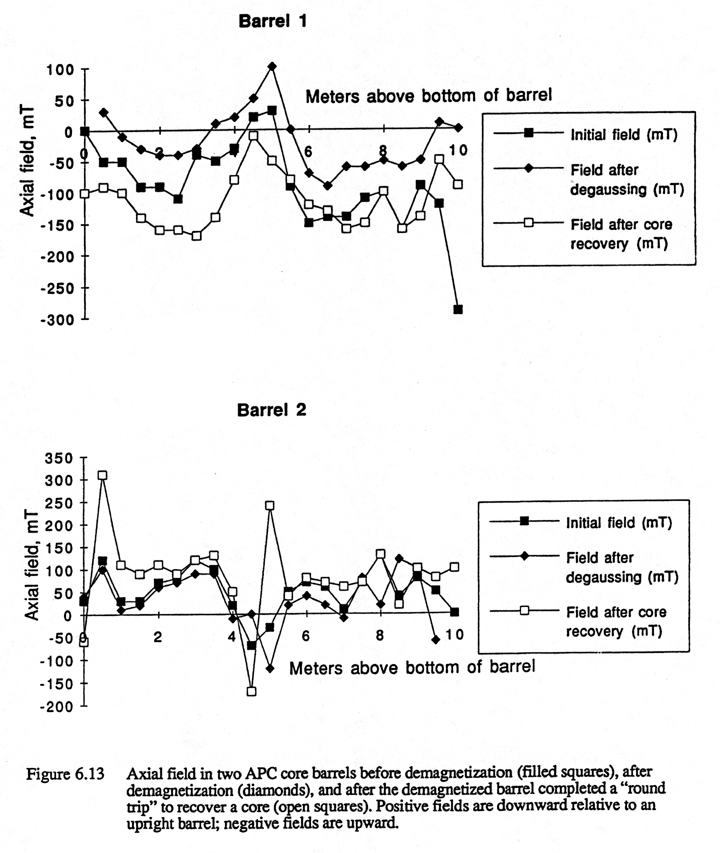
Two further noteworthy observations were made during this study. While the axial magnetization of the first core barrel was directed upward (negative sign), corresponding to the common observation that the drilling-induced remanence is steeply upward, the magnetization of the second barrel was dominantly directed downward (positive sign). These directions of magnetization were repeated when the barrels were remagnetized during their coring deployment, even though the conditions to which the two barrels were exposed were presumably similar. The explanation for the different magnetization of the two barrels is not clear, but this effect may contribute to the observation of differences in the drilling-induced overprint with alternation of core barrels. The other surprise was the intensity of the field measured near the joint at the top of a stand of drill pipe as this was sitting in the elevator: a field of 1700 mT was apparently measured. While it is probable that the Hall Effect meter had gone out of calibration at this point, it is clear that a very strong field was present, and this is consistent with anecdotal stories of iron wrenches being stuck hard to the pipe.
What is clear from this study is that core-barrel demagnetization is of little value as an isolated measure. Remagnetization of the barrel occurs during a single deployment, and high field sources remain in the drill pipe and on the rig floor. Some advantage might be gained by the use of nonmagnetic monel core barrels, but this would have to be weighed against the cost and limited tensile strength of these barrels (which would lower the overpull limit on APC coring, for instance). However, such nonmagnetic core barrels may be justified in cases where minimization of drilling-induced remanence is of paramount importance.
Despite these difficulties, the majority of ODP paleomagnetic studies have been successful. Frequently no significant drilling-induced remanence is observed. In most other cases, shipboard 15-mT AF demagnetization has been sufficient to remove the drilling-induced remanence, at least sufficiently for recognition of primary polarity. AF and/or thermal demagnetization of discrete samples is usually able to remove this overprint totally, allowing characteristic remanences to be isolated. Only rarely has the drilling-induced remanence totally obscured the characteristic remanence. Of more concern may be the replacement of VRM by drilling-induced remanence, which may preclude the use of VRM as a reference orientation for the core.
The upper and lower boundaries of each section introduce an edge effect in continuous cryogenic magnetometer measurements. This is reflected both in a decrease in the intensity measured near section breaks, and in localized anomalies in declination and inclination. When section records are concatenated, the origin of these anomalous intensities and directions as edge effects can be overlooked, and there is a risk that they may be interpreted as having real paleomagnetic significance (see Fig. 6.8).
Steel drill pipe exposed to seawater will inevitably rust. Usually rust
contamination is not a serious problem. ODP drill pipe is coated to minimize
rusting, both to extend the life of the pipe and to minimize contamination of
the magnetic record. Cycling of the drill pipe for recoating occurs on a
roughly 2- to 3-year rotation, which should be frequent enough to minimize
rust development. Nevertheless, rust contamination of the cores does occur,
and may sometimes seriously degrade, or even completely obscure, both the
magnetization and susceptibility records. Usually, rust will be seen as a
high-susceptibility/magnetization spike" at the top of cores, resulting from
offscraping of internal rust during the up and down passage of the core
barrel between intervals of coring (Fig. 6.14). Occasionally this problem
can be more severe, and the effects of rust may extend throughout the core.
Severe rust contamination is most likely when a deep-water hole follows an
extended period of drilling in shallower water, so that pipe which has not
been used for some time (and in which rust has had the opportunity to
accumulate) is reintroduced to the drill string.

The problem may also occur after pipe is rotated around in the racker, or after new pipe has been brought onto the ship during a port call. Rust contamination will be present on the upper surface of the core, and may be present in the drilling slurry annulus around the core inside the core liner. It is likely only to be present deeper inside the core when the core has been fluidized, in which case magnetic measurements are of no value. Rust in the annulus of drilling slurry will affect susceptibility measured using the MST, and intensity and direction measured in archive-half sections using the cryogenic magnetometer. However, it should still be possible to select uncontaminated discrete samples for remanence and susceptibility measurements.